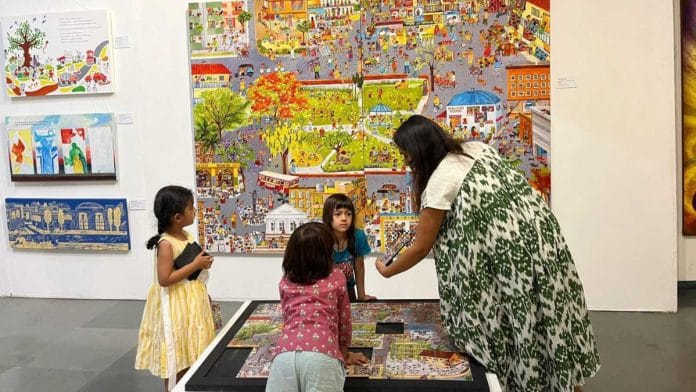New Delhi: At the art gallery in Delhi’s India International Centre, a sombre-looking middle-aged man flipped the pages of Rumi’s What Shape is an Elephant. A woman with a walking stick revisited her childhood through some of the earliest ever children’s book illustrations.
Vignettes from children’s literature, pieced together to form ‘Becoming’, an exhibition exploring an oeuvre that has taken shape over the past 130 years, hit home for adults as well. Works by illustrators like Priya Kurian, Kaniya Kini, Arabindranath Roy, and Satyajit Ray were on display. Images were given primacy, with the book title finding mention later. At the entrance, a string of books were strung together. Some were placed by the display—freely available for viewers to read. There’s also a puzzle mirroring an illustration of the city, being attempted by eager-eyed toddlers. “Mushroom. This is a mushroom,” a child knowledgably told her father, who nodded in assent.
This is what curator Richa Jha, also the founder of Pickle Yolk Books, wanted to achieve.
“The idea is that these are books for all ages. They often get sidelined because people believe they’re too simple. The fact is that the kinds of issues they’re talking about, the way they’re making sense of the world, is astounding. The authors, the illustrators, the editors—no one is pussyfooting,” she told ThePrint. “They’re not scared of asking questions.”
Becoming is lifelong. As a process, it can be stretched, elongated, or moulded. That’s why, in all its complexity, it grew to be the axis on which the exhibition rests. There are three intersecting categories of the act: time, space and the self, all suspended in perpetuity. While technically the illustrations belong to books targeted at children, the messaging as well as the depth of interaction with the world and the human experience is profoundly ‘adult’.
In a world where awareness is mounting, and children are forced to engage in meaning-making at an early age, children’s literature plays a pressing role. Illustrations provide a pathway, permitting children to arrive at their own conclusions.
A child stands. Hands on their hips, whorls of hair that seek to exit the page, and their peers—with expressions that range from discomfited to jeering. “Most boys have short hair/but you like yours long/It’s okay to stand out/and sing your own song,” says the text. This has been categorised as part of self.
Another illustration makes sense of climate change and its real-world manifestations. The illustration portrays a young girl, from whom the world springs. There’s smoke emanating from a city, jellyfish in the ocean, and a fox sleeping in an oasis of green. Drawn by Canato Juno, the messaging is straightforward. The picture itself is intricate, but remarkably clear. And there’s an obvious tendril of hope. The piece falls into space.
“Becoming is the most enduring reality of our lives. It’s a theme that can bring out the richness of our literature,” Richa Jha said.
Also read: Young, Left, and reading—Delhi’s May Day Bookstore celebrates Workers’ Day for the 13th year
Timelessness of illustrations
India’s tryst with children’s literature dates back to the late 1800s, courtesy of a Bengali magazine named Sandesh. The original illustrators are a distinguished lot. There’s Sukumar Ray, father of Satyajit Ray, Abanindranath Tagore, and the Pather Panchali maker himself.
Each illustration by them has a timelessness. In fact, it appears almost as though the famous Quentin Blake, illustrator of Roald Dahl’s iconic children’s fiction, has borrowed extensively from the style conceptualised by these masters.
“They had their own printing presses and really institutionalised children’s literature, making it what it was,” said Jha.
Work seemingly directed at children has long evoked the aesthetics of the socio-political climate. The era of Nehru was another heady time, with the formation of the National Book Trust and the Children’s Book Trust. Books of this period were concerned with nation-building, and reading was marketed as a national, essential pass-time among children.
Then came the 1990s, and the arrival of independent publishing houses. Tulika Books and Tara, as well as a host of others, began to push the envelope—widening the scope of children’s literature.
An image on display is a companion to a poem by the famous Bihari poet Nagarjun. The work of anti-caste thinkers Mahasweta Devi and Kancha Ilaiah Shepherd has also been brought alive. Confrontations of caste, patriarchy, and the various cruel structures are a relatively new phenomenon in India’s oeuvre—having picked up steam in the last decade or so.
The signalling is evident: to be kinder to the world and ourselves, to be inclusive, to be free.
“The idea is to give children the tools and the language to navigate the tough things in life,” said Jha.
And adults, too.
(Edited by Ratan Priya)







Ms. Anatara Baruah, the name is Abanindranath Tagore. Being a Bengali, the least you can do is to not mess up the name of a legendary Bengali intellectual.